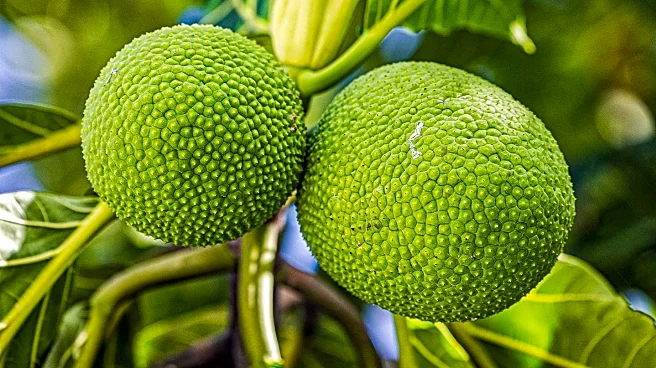What's Happening?
Russell Fielding, an associate professor at Coastal Carolina University, has authored a new book titled 'Breadfruit: Three Global Journeys of a Bountiful Tree.' The book, set to be released in December, delves into the historical journey of breadfruit as it spread across the globe during colonial times. Fielding's work examines the various uses of breadfruit in different regions, highlighting its significance in agricultural and cultural contexts. The book includes insights from Fielding's visits to experimental gardens and farms in locations such as Guam, Maui, French Polynesia, and Ghana, where he explored the cultivation and utilization of breadfruit.
Why It's Important?
Breadfruit is a versatile and nutritious crop that has played a significant role in food security and cultural practices in many regions. Fielding's exploration of its global journey provides valuable insights into how colonialism influenced agricultural practices and the spread of crops. Understanding the historical context of breadfruit can inform current discussions on sustainable agriculture and food sovereignty, particularly in regions where breadfruit is a staple. The book's release may spark interest in the broader implications of crop distribution and its impact on local economies and cultures.
What's Next?
The release of 'Breadfruit: Three Global Journeys of a Bountiful Tree' may lead to increased academic and public interest in the historical and cultural significance of breadfruit. Discussions around sustainable agriculture and food security could benefit from the insights provided in Fielding's research. Additionally, the book may encourage further studies on the impact of colonialism on global agricultural practices and the spread of crops. Fielding's work could also inspire initiatives to promote breadfruit cultivation as a means to enhance food security in regions facing agricultural challenges.
Beyond the Headlines
Fielding's book not only traces the historical journey of breadfruit but also highlights the ethical and cultural dimensions of crop distribution. The spread of breadfruit during colonial times reflects broader themes of cultural exchange and adaptation. By examining the uses of breadfruit in different regions, the book sheds light on how communities have integrated this crop into their cultural practices, offering a deeper understanding of the relationship between agriculture and cultural identity.










